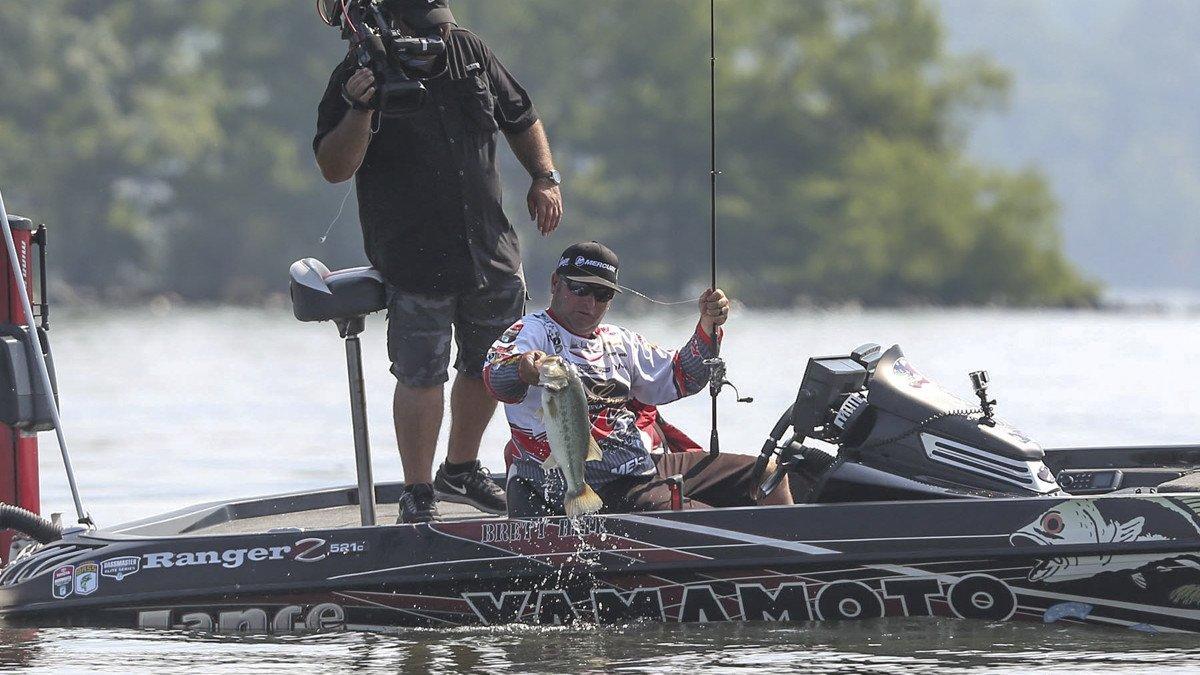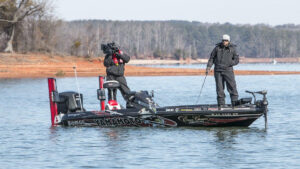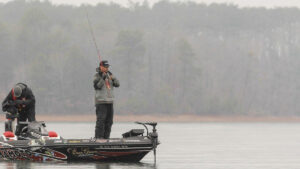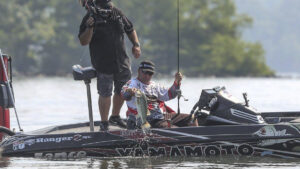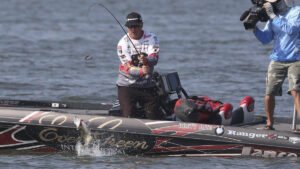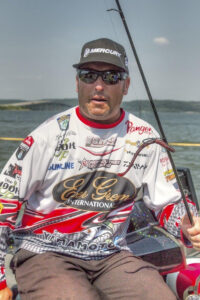If you watched BASSFest on TV or were fortunate enough to make out for the event on Kentucky Lake, you probably heard a bit about Brett Hite. Namely he finished third with 91 pounds, 9 ounces for 4 days of bass fishing on deep river ledges. What many found out was he caught all 91 pounds of bass on a spinning rod. And he is proving that finesse fishing can catch bigger bass.
Anglers like Brett Hite, Brent Ehrler, Justin Lucas and David Dudley have used finesse fishing tactics to put not just more bass but bigger bass in the boat to win major professional bass fishing tournaments. And it’s interesting to see how finesse has changed in the last few years and the advantages and tips you can pick up to make it work more for you in your own fishing.
Here are 5 things to consider for fishing with finesse gear in today’s bass fishing:
- The 2 out of 3 rigs
- Upsize your gear
- Light wire better
- Playing bigger bass
- Neko rig magic
THE 2 OUT OF 3 FINESSE RIGS
Brett Hite has used a drop shot rig and a Neko rig on his finesse gear for the last decade with incredible success. While he acknowledges the power of the third popular finesse presentation, a shaky head, he doesn’t use one much if at all in competition.
“The drop shot and Neko rigs are my staples in finesse fishing,” Hite said. “I’m not really a shaky head guy, but those are the three main techniques guys think about for finesse.”
The drop shot has proven itself as one of the best pure fish catchers ever invented. When all other presentations fail, it seems that one still produces. From water 1 foot deep to 60 feet deep. Hite finished 7th at the 2015 Bassmaster Classic on Lake Hartwell by catching bass from the frigid waters as deep as 50 feet on a drop shot. At Kentucky Lake he was plying 20-foot ledges on the main river and producing bigger catches than competitors fishing literally feet from him.
“I fish a drop shot vertical a lot, but I cast it a lot as well,” he said. “It has become one of the best bed fishing baits you can use. You can fish grass lines, pitch it around bushes, fish it effectively in one foot or 50 feet.
When Hite fishes a drop shot around grass he uses brighter colors for contrast so the bass can find it easier. But when he’s fishing open water, he sticks with more translucent and natural colors.
Most of the time while fishing a drop shot or a Neko rig (more about that later), he is pulling it along the bottom. The tungsten weights amplify what you feel on the bottom. If he is pulling his baits up a hill, he will work his rod high to help it get over the cover. If he’s on top of a ledge or a flat, he will pull it along from the side. When he feels some cover, he will stop the baits and try to move them in place but shaking or giving the bait slack and tightening back up on it.
UPSIZE YOUR GEAR
“Aaron Martens, Koto Kiryama, and I made drop shot fishing popular out west,” Hite said. “When we started, we were using little 2 and 3-inch shad style baits. We used little bitty hooks, 4- and 6-pound line and medium light rods.”
Nowadays, Hite has upgraded his gear from hooks to rods. He traded in 6-foot, 10-inch medium light rods for 7-foot, 3-inch softer-action, medium-heavy rods. With that rod he gets much longer casts and better hooksets at the end of long casts. That’s partly thanks to upgrading to 10 to 15-pound braided fishing line, which Hite never fishes without on finesse gear.
He went from 5-pound fluorocarbon to 15 pound braid. But he also went from 3-inch baits to 7 1/2 and 8-inch baits. He will still use the smaller skinny worms but when he’s going to a fishery with a big bass population, he will beef up his offering to 7 or 8 inch fat worm with bigger hooks.
His Neko Rig at BASSFest was a 7 3/4-inch Yamamoto Kut Tail Worm rigged on a 1/0 Aaron Martens TGW Gamakatsu Nano hook.
LIGHT WIRE BETTER
While he advocates getting more backbone in your rod and more line management with braid, he does advocate using light wire hooks. If he’s nose hooking a 6-inch Straight Tail Roboworm or a Yamamoto Shad Shape Worm (which he considers the best nose hook bait of all time for drop shots), he will use a No. 1 or 1/0 Gamakatsu Aaron Martens TGW hook.
However when he’s fishing bigger worms like the 6 1/2-inch Kut Tail Worm, he will go with the 1/0 or 2/0 Gamakatsu ReBarb Hooks in the light wire. While folks will immediately assume the light-wire hooks bend out with braid, Hite has found that on a long cast, in deep water, the bass are more difficult to stick. The light wire does a much better job of penetrating a fish’s mouth than the heavier gauge wire does.
Think about your own skin. Would it be easier to push a needle into your arm or a 10-penny nail?
However, keep in mind, there is a pretty specific way you need to handle a big bass on a light wire hook with this setup.
PLAYING BIGGER BASS
Hite caught every bass in the Bassmaster Classic and every bass in BASSFest on spinning rod. At BASSFest, 10 of his 20 bass weighed more than 5 pounds. So he’s developed a sense for hooking, fighting and landing bigger bass on lighter finesse gear.
“I keep a real tight drag on the hookset,” Hite said. “As soon as I hit the fish and get a few cranks, I start loosening my drag. You need the hook penetration, but when a 5- or 6-pounder bites, you need to let your drag help play the fish down and not bend the hook or pull it loose. I have no problem landing big bass like this.”
NEKO RIG MAGIC
Hite and several others have been able to keep the Neko rig quiet for a few years. The nail weight inserted into the head of a worm with an O-ring around the worm with a small hook on the O-ring gives the Neko rig a unique presentation to the bass. Something they don’t see as much. And, the angler can employ much larger worms than with typical finesse presentations.
“One mistake I see guys make is they want to work the rig too much,” Hite said. “I want mine on the bottom the whole time. I pull it along until I contact cover, then I will shake it when I think I’m around something a bass would use for cover.”
The Neko rig has always been a deep water tactic. In early 2000, there were guys doing it and winning from the back of the boat out west. It’s simply taking a wacky rig and modifying it to fish in deeper water. Nail weights give the bait more depth. And in a pinch, Hite will jam a tungsten drop-shot weight into the head of the bait.
Hite likes a Reins tungsten nail weight in 3/32 to 3/16 ounce. He stresses using an O-ring because you will lose a lot of weights and worms otherwise.
Keep in mind the Neko rig is not very effective around wood cover because the hook is exposed, but otherwise it’s very effective for catching deep bass.
“Anymore if there is a tournament lake we go to, most all of those lakes are very pressured and big bodies of water,” Hite said. “They are places that have a lot of bass fishing. It’s something you have to always be thinking about. If I go to Okeechobee, I’m not reaching for my finesse stuff. But 90% of the time, finesse is going to play a big role in catching those pressured bass.”


